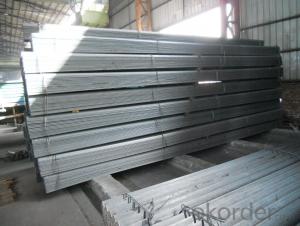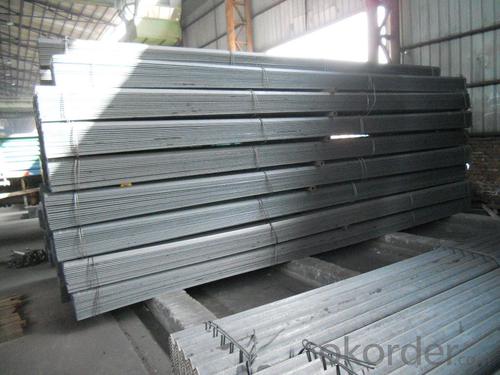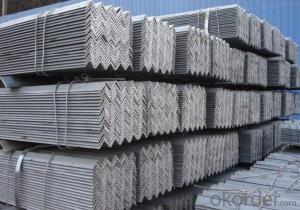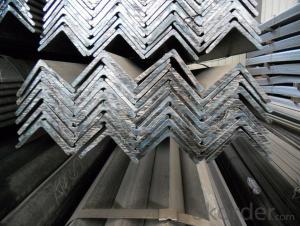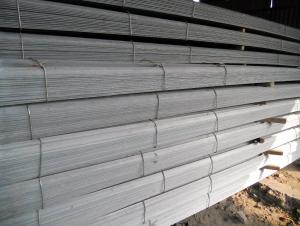Prime Low Carbon Angle Steel with Stable Quality
- Loading Port:
- China main port
- Payment Terms:
- TT OR LC
- Min Order Qty:
- 100 m.t.
- Supply Capability:
- 20000 m.t./month
OKorder Service Pledge
OKorder Financial Service
You Might Also Like
Product Description:
OKorder is offering Prime Low Carbon Angle Steel with Stable Quality at great prices with worldwide shipping. Our supplier is a world-class manufacturer of steel, with our products utilized the world over. OKorder annually supplies products to African, South American and Asian markets. We provide quotations within 24 hours of receiving an inquiry and guarantee competitive prices.
Product Applications:
Prime Low Carbon Angle Steel with Stable Quality are ideal for structural applications and are widely used in the construction of buildings and bridges, and the manufacturing, petrochemical, and transportation industries.
Product Advantages:
OKorder's Prime Low Carbon Angle Steel with Stable Quality are durable, strong, and wide variety of sizes.
Main Product Features:
· Premium quality
· Prompt delivery & seaworthy packing (30 days after receiving deposit)
· Can be recycled and reused
· Mill test certification
· Professional Service
· Competitive pricing
Product Specifications:
Manufacture: Hot rolled
Grade: Q195 – 235
Certificates: ISO, SGS, BV, CIQ
Length: 6m – 12m, as per customer request
Packaging: Export packing, nude packing, bundled
| EQUAL ANGLE STEEL | |||||
| size(mm) | a(mm) | a1(mm) | thickness(mm) | kg/m | length |
| 50*50*4 | 50 | 50 | 4 | 3.059 | 6m,9m,12m |
| 50*50*5 | 50 | 50 | 5 | 3.77 | 6m,9m,12m |
| 50*50*6 | 50 | 50 | 6 | 4.465 | 6m,9m,12m |
| 63*63*5 | 63 | 63 | 5 | 4.822 | 6m,9m,12m |
| 63*63*6 | 63 | 63 | 6 | 5.721 | 6m,9m,12m |
| 65*65*5 | 65 | 65 | 5 | 5 | 6m,9m,12m |
| 65*65*6 | 65 | 65 | 6 | 5.91 | 6m,9m,12m |
| 65*65*8 | 65 | 65 | 8 | 7.66 | 6m,9m,12m |
| 75*75*5 | 75 | 75 | 5 | 5.818 | 6m,9m,12m |
| 75*75*6 | 75 | 75 | 6 | 6.905 | 6m,9m,12m |
| 75*75*8 | 75 | 75 | 8 | 9.03 | 6m,9m,12m |
| 75*75*9 | 75 | 75 | 9 | 9.96 | 6m,9m,12m |
| 75*75*10 | 75 | 75 | 10 | 11.089 | 6m,9m,12m |
| 80*80*6 | 80 | 80 | 6 | 7.375 | 6m,9m,12m |
| 80*80*7 | 80 | 80 | 7 | 8.525 | 6m,9m,12m |
| 80*80*8 | 80 | 80 | 8 | 9.658 | 6m,9m,12m |
| 80*80*10 | 80 | 80 | 10 | 11.874 | 6m,9m,12m |
| 90*90*6 | 90 | 90 | 6 | 8.35 | 6m,9m,12m |
| 90*90*7 | 90 | 90 | 7 | 9.656 | 6m,9m,12m |
| 90*90*8 | 90 | 90 | 8 | 10.946 | 6m,9m,12m |
| 90*90*10 | 90 | 90 | 10 | 13.476 | 6m,9m,12m |
| 100*100*6 | 100 | 100 | 6 | 9.366 | 6m,9m,12m |
| 100*100*7 | 100 | 100 | 7 | 10.83 | 6m,9m,12m |
| 100*100*8 | 100 | 100 | 8 | 12.276 | 6m,9m,12m |
| 100*100*9 | 100 | 100 | 9 | 13.49 | 6m,9m,12m |
| 100*100*10 | 100 | 100 | 10 | 15.12 | 6m,9m,12m |
| 100*100*12 | 100 | 100 | 12 | 17.898 | 6m,9m,12m |
| 120*120*8 | 120 | 120 | 8 | 14.88 | 6m,9m,12m |
| 120*120*10 | 120 | 120 | 10 | 18.37 | 6m,9m,12m |
| 120*120*12 | 120 | 120 | 12 | 21.66 | 6m,9m,12m |
| 125*125*8 | 125 | 125 | 8 | 15.504 | 6m,9m,12m |
| 125*125*10 | 125 | 125 | 10 | 19.133 | 6m,9m,12m |
| 125*125*12 | 125 | 125 | 12 | 22.696 | 6m,9m,12m |
| 130*130*10 | 130 | 130 | 10 | 19.8 | 6m,9m,12m |
| 130*130*12 | 130 | 130 | 12 | 23.6 | 6m,9m,12m |
| 130*130*13 | 130 | 130 | 13 | 25.4 | 6m,9m,12m |
| 130*130*14 | 130 | 130 | 14 | 27.2 | 6m,9m,12m |
| 150*150*10 | 150 | 150 | 10 | 23 | 6m,9m,12m |
| 150*150*12 | 150 | 150 | 12 | 27.3 | 6m,9m,12m |
| 150*150*14 | 150 | 150 | 14 | 31.6 | 6m,9m,12m |
| 150*150*15 | 150 | 150 | 15 | 33.8 | 6m,9m,12m |
| 140*140*10 | 140 | 140 | 10 | 21.49 | 6m,9m,12m |
| 140*140*12 | 140 | 140 | 12 | 25.52 | 6m,9m,12m |
| 140*140*14 | 140 | 140 | 14 | 29.49 | 6m,9m,12m |
| 160*160*10 | 160 | 160 | 10 | 24.73 | 6m,9m,12m |
| 160*160*12 | 160 | 160 | 12 | 29.39 | 6m,9m,12m |
| 160*160*14 | 160 | 160 | 14 | 33.99 | 6m,9m,12m |
| 180*180*12 | 180 | 180 | 12 | 33.16 | 6m,9m,12m |
| 180*180*14 | 180 | 180 | 14 | 39.39 | 6m,9m,12m |
| 180*180*16 | 180 | 180 | 16 | 43.45 | 6m,9m,12m |
| 180*180*18 | 180 | 180 | 18 | 48.63 | 6m,9m,12m |
| 200*200*14 | 200 | 200 | 14 | 42.89 | 6m,9m,12m |
| 200*200*16 | 200 | 200 | 16 | 48.68 | 6m,9m,12m |
| 200*200*18 | 200 | 200 | 18 | 54.4 | 6m,9m,12m |
| 200*200*20 | 200 | 200 | 20 | 60.06 | 6m,9m,12m |
| 200*200*24 | 200 | 200 | 24 | 71.17 | 6m,9m,12m |
FAQ:
Q1: Why buy Materials & Equipment from OKorder.com?
A1: All products offered byOKorder.com are carefully selected from China's most reliable manufacturing enterprises. Through its ISO certifications, OKorder.com adheres to the highest standards and a commitment to supply chain safety and customer satisfaction.
Q2: How do we guarantee the quality of our products?
A2: We have established an advanced quality management system which conducts strict quality tests at every step, from raw materials to the final product. At the same time, we provide extensive follow-up service assurances as required.
Q3: How soon can we receive the product after purchase?
A3: Within three days of placing an order, we will arrange production. The normal sizes with the normal grade can be produced within one month. The specific shipping date is dependent upon international and government factors, the delivery to international main port about 45-60days.
Images:
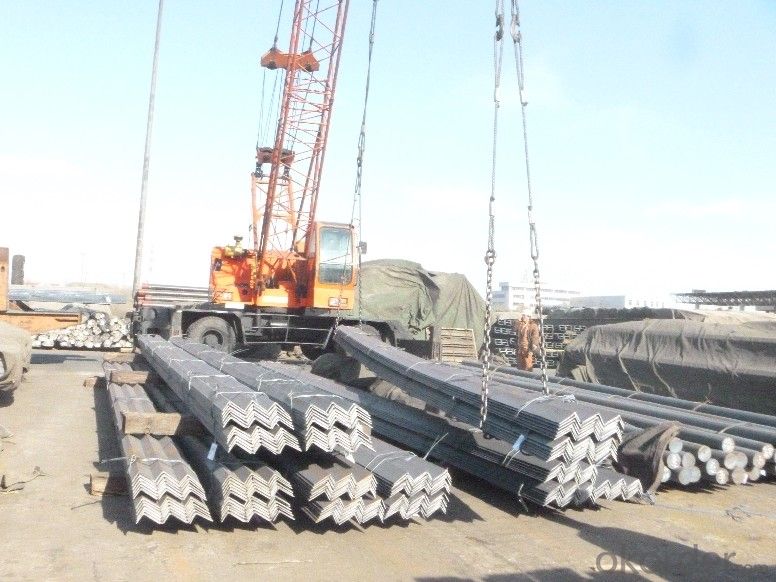
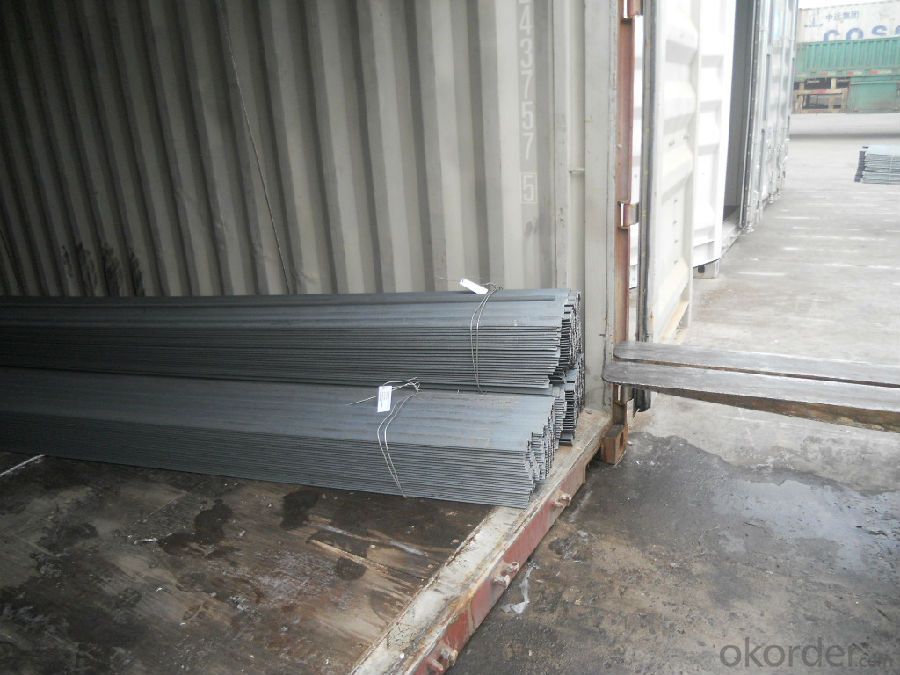
- Q: Can steel angles be used in playground equipment?
- Yes, steel angles can be used in playground equipment. They are often used as structural components to provide stability and support, such as in the frames of slides, climbing structures, or swing sets.
- Q: Can steel angles be used in the construction of sports stadiums?
- Sports stadiums can indeed utilize steel angles in their construction. These versatile structural components are capable of bearing heavy loads and providing stability in expansive structures like sports stadiums. They are commonly employed in the construction industry for a variety of purposes, including framing, support columns, and bracing systems. Steel angles possess remarkable strength and durability, rendering them suitable for enduring the dynamic forces and substantial loads encountered within sports stadiums. Furthermore, steel angles can be easily fabricated and tailored to meet the precise design and structural prerequisites of the stadium, thereby offering construction flexibility. All in all, steel angles emerge as an ideal selection for sports stadium construction due to their robustness, versatility, and ability to withstand the distinctive demands of such large-scale edifices.
- Q: How are steel angles protected against chemical exposure?
- Steel angles can be protected against chemical exposure through various methods. One common method is the application of protective coatings. These coatings, such as epoxy or polyurethane coatings, act as a barrier between the steel angle and the chemicals it may come into contact with. The coatings are designed to be resistant to chemical attack and prevent corrosion or degradation of the steel. Another method of protecting steel angles against chemical exposure is by using stainless steel. Stainless steel contains a high level of chromium, which forms a protective oxide layer on the surface of the steel. This oxide layer acts as a barrier against chemical attack, preventing corrosion and degradation of the steel angle. In addition to coatings and stainless steel, steel angles can also be protected by using acid-resistant materials. These materials are specifically designed to resist the corrosive effects of chemicals and can be used to line tanks or containers that store or transport chemicals. By using acid-resistant materials, the steel angle is shielded from direct contact with the chemicals, reducing the risk of corrosion or damage. Regular maintenance and inspection are also crucial for protecting steel angles against chemical exposure. Inspecting the angles for any signs of damage or corrosion allows for early detection and intervention. Any damaged protective coatings can be repaired or replaced to ensure the continued protection of the steel angle. Overall, steel angles can be protected against chemical exposure through the application of protective coatings, the use of stainless steel, the use of acid-resistant materials, and regular maintenance and inspection. These measures help to prevent corrosion, degradation, and damage to the steel angle, ensuring its longevity and performance in chemical environments.
- Q: Are steel angles suitable for architectural sculptures or installations?
- Yes, steel angles are suitable for architectural sculptures or installations due to their versatility, strength, and structural integrity. They can be easily shaped and welded to create intricate designs and support heavy structures, making them a popular choice for artistic and functional installations in architecture.
- Q: Are steel angles available in non-standard sizes or custom shapes?
- Yes, steel angles are available in non-standard sizes and can be custom made to specific shapes based on the requirements of the project or design.
- Q: Are steel angles resistant to impact or vibration?
- Steel angles are generally resistant to both impact and vibration. Steel is known for its strength and toughness, making it highly resistant to impact. It can absorb and distribute the force generated by an impact, preventing structural damage. Additionally, steel angles have a high natural frequency, which means they can withstand vibrations without experiencing significant deformation or failure. However, the resistance of steel angles to impact and vibration may vary depending on the specific grade and thickness of the steel, as well as the intensity and duration of the impact or vibration. It is important to consider the specific requirements and conditions of the application when determining the suitability of steel angles for impact and vibration resistance.
- Q: How do you reinforce a steel angle for added stability?
- One way to reinforce a steel angle for added stability is by adding gussets or diagonal braces. These additional elements can be attached to the steel angle to increase its strength and resistance to bending or twisting forces.
- Q: What are the different methods of reinforcing steel angles?
- There are several methods of reinforcing steel angles, each with its own advantages and applications. One common method is the use of additional steel plates or brackets. These plates or brackets are typically welded or bolted to the existing steel angle to provide additional support and strength. This method is often used in applications where the steel angle is subject to high loads or stresses. Another method is the use of stiffeners, which are typically smaller steel angles or plates welded perpendicular to the existing angle. These stiffeners help to distribute the load more evenly and prevent the steel angle from buckling or bending under stress. This method is often used in applications where the steel angle is used as a structural member, such as in building frames or bridge supports. Additionally, reinforcing steel angles can be achieved through the use of concrete encasement or composite materials. In this method, the steel angle is embedded within a concrete matrix or combined with other materials such as fiberglass or carbon fiber. This combination provides enhanced strength, durability, and resistance to corrosion. This method is commonly used in construction projects where the steel angle is exposed to harsh environments or requires high performance. Overall, the different methods of reinforcing steel angles provide options for increasing the strength, stability, and durability of these structural components. The choice of method will depend on the specific application, load requirements, and environmental factors.
- Q: Can steel angles be painted or coated?
- Yes, steel angles can be painted or coated. Painting or coating steel angles helps to prevent corrosion and provides aesthetic appeal.
- Q: How do you prevent welding distortion in steel angles?
- To prevent distortion in steel angles during welding, there are several strategies that can be implemented: 1. Ensure proper welding technique by correctly setting welding parameters, such as voltage, current, and travel speed, to control heat input. This prevents excessive heating of the steel angles, which can cause distortion. 2. Prepare the steel angles before welding by cleaning surfaces to remove dirt, oil, or rust. Also, bevel the edges of the angles to create a V-groove joint. This allows for better penetration and reduces the risk of distortion. 3. Temporarily hold the steel angles in place using tack welds before final welding. Strategically place these tack welds to evenly distribute stresses during welding and minimize distortion. 4. Determine the most suitable weld sequence for the specific joint configuration. Start welding from the center and progress outwards, alternating sides to balance heat input. This helps avoid localized overheating and subsequent distortion. 5. Use fixtures or clamps to hold the steel angles in place during welding. This ensures they remain in the correct position and minimizes distortion caused by movement or displacement during welding. 6. Consider preheating the steel angles before welding to reduce the risk of distortion. Controlled post-weld heat treatment may also be applied to relieve residual stresses and minimize distortion. 7. Adjust the welding sequence if the steel angles are part of a larger assembly. This involves welding in a specific order to balance shrinkage forces and reduce overall distortion of the assembly. By implementing these measures, welding distortion in steel angles can be effectively prevented, resulting in high-quality welds and ensuring the structural integrity of the fabricated components.
Send your message to us
Prime Low Carbon Angle Steel with Stable Quality
- Loading Port:
- China main port
- Payment Terms:
- TT OR LC
- Min Order Qty:
- 100 m.t.
- Supply Capability:
- 20000 m.t./month
OKorder Service Pledge
OKorder Financial Service
Similar products
Hot products
Hot Searches
Related keywords
